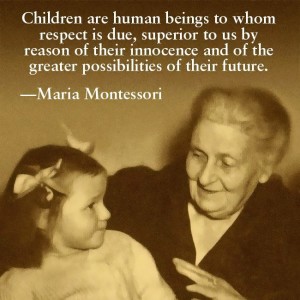If you visit a Montessori classroom, you will find many things the same as a traditional preschool classroom. You will also find differences. Some differences will be because of the culture of the area. There may be other differences because of the interpretation of Montessori’s methods.
Maria Montessori was a doctor who worked with developmentally delayed children in Rome. She discovered that if she observed children she could discover much about what they needed in order to learn and flourish. Montessori was one of the first people to see the importance of observing children in order to plan an appropriate environment and curriculum to meet their needs.
Montessori discovered that children, by nature, are curious and wish to learn. She also discovered that given the appropriate environment and materials children will choose to apply themselves to learning.
Montessori was one of the first people to create an environment specifically for small children. Her schools were eventually referred to as “children’s houses” partially because she created child sized furniture and kept materials where children could reach them on low shelve.
Montessori Classroom Environment
The environment in a preschool Montessori classroom is still very important. Classrooms are arranged in a pleasant way with low shelves for materials. Tables and chairs are just the right size for the children. The total environment is aesthetic and interesting. The classroom is divided into several interest areas.
As she observed the children in her care Montessori realized that children are more likely to stay focused if they are doing something real rather than something contrived. Children took pride in their environment as they took care of it themselves.
She provided them with small brooms and dustpans. She found small pitchers the children could use in order to pour their own drinks. She believed that small children should learn every day living skills that would serve them the rest of their lives.
Children in the classroom are still encouraged to clean tables prepare their own snacks, sweep floors and put everything away when they are done. Children who are confident that they can take care of their environment and take care of their own needs develop self esteem.

